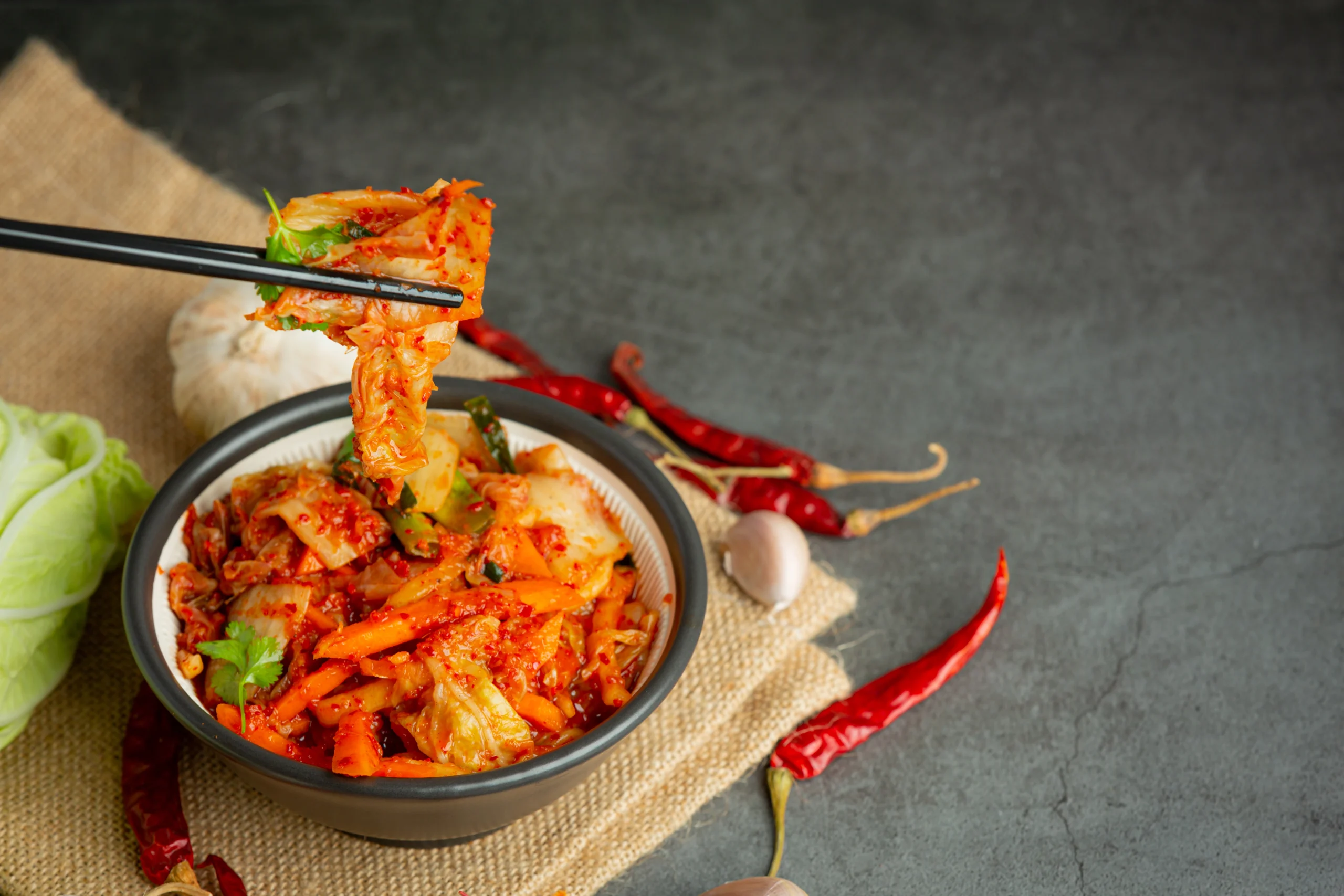Kimchi : The Iconic Korean Culinary Treasure
Introduction: What is Kimchi?
Kimchi is a traditional Korean dish made from fermented vegetables, most commonly Napa cabbage and radishes, combined with a flavorful mix of spices and seasonings. Known for its tangy, spicy, and umami-rich profile, kimchi is a staple in Korean cuisine and has become a beloved dish around the world. Beyond its distinctive taste, kimchi is celebrated for its health benefits, particularly its role as a probiotic-rich food that supports gut health.

Table of Contents
A Brief History of Kimchi
Kimchi’s origins date back thousands of years, with the earliest references appearing in ancient Korean texts from the Three Kingdoms Period (57 BCE–68 CE). In these early days, kimchi was a simple form of salted and fermented vegetables, created to preserve food during Korea’s harsh winters.
The dish evolved significantly during the Joseon Dynasty (1392–1897), when red chili peppers were introduced to Korea in the 17th century via trade routes. This addition transformed kimchi, giving it the characteristic spiciness we associate with modern versions. Over centuries, regional variations and innovations have given rise to hundreds of types of kimchi, each with its unique flavor profile and preparation method.
Ingredients: What Makes Kimchi Special?
The key to kimchi’s unique taste lies in its carefully selected ingredients and their harmonious combination. While recipes vary, the following components are foundational:
1. Vegetables
- Napa Cabbage: The most common base for kimchi.
- Korean Radish (Mu): Often used for its crunchy texture.
2. Seasonings
- Red Chili Pepper Flakes (Gochugaru): Adds heat and vibrant red color.
- Garlic: Provides a robust, aromatic flavor.
- Ginger: Offers a hint of spice and warmth.
- Green Onion: Adds a mild, oniony zest.
3. Fermentation Agents
- Salt: Essential for preserving and fermenting the vegetables.
- Fish Sauce or Fermented Shrimp (Saeujeot): Adds depth and umami.
- Rice Paste: Occasionally used to aid fermentation and texture.
4. Optional Additions
- Fruits: Apples or pears can add sweetness.
- Seafood: Oysters or anchovies enhance complexity.
How to Eat Kimchi
Kimchi is incredibly versatile and can be enjoyed in countless ways:
1. As a Side Dish (Banchan)
Kimchi is traditionally served as a side dish alongside rice, soup, and other Korean dishes. Its tangy and spicy flavor complements a variety of meals.
2. In Main Dishes
- Kimchi Stew (Kimchi Jjigae): A hearty and warming soup featuring aged kimchi, tofu, pork, or seafood.
- Kimchi Fried Rice (Kimchi Bokkeumbap): A quick and flavorful dish made with leftover rice and kimchi.
- Kimchi Pancakes (Kimchi Jeon): A crispy, savory treat ideal as an appetizer or snack.
3. As a Topping
Kimchi can be used as a topping for tacos, burgers, and even pizza, adding a tangy and spicy kick to global cuisines.
The Cultural Significance of Kimchi
Kimchi is more than just food; it’s a symbol of Korean identity and heritage. The act of making kimchi, known as Kimjang, has been recognized by UNESCO as an Intangible Cultural Heritage of Humanity. Kimjang is a communal activity where families and communities gather to prepare large quantities of kimchi for the winter months. This tradition fosters a sense of community and connection to Korean culture.

Kimchi’s Global Journey
From Korea to the World
Kimchi’s journey to international recognition began with the Korean diaspora. As Koreans migrated to different parts of the world, they brought their culinary traditions with them, introducing kimchi to new audiences.
The Hallyu Wave
The rise of Hallyu, or the Korean Wave, has significantly boosted kimchi’s global popularity. Through K-dramas, K-pop, and Korean films, international audiences have become increasingly interested in Korean culture and cuisine, with kimchi often featured as an integral part of Korean meals.
Fusion Cuisine
Kimchi has also become a star ingredient in fusion cuisine, inspiring chefs worldwide to incorporate it into non-traditional dishes like kimchi tacos, kimchi grilled cheese, and even kimchi Bloody Mary cocktails.
Health Benefits of Kimchi
Kimchi is not only delicious but also highly nutritious. Its fermentation process produces probiotics, which support gut health by improving digestion and boosting immunity. Additionally, kimchi is rich in vitamins A, B, and C, as well as antioxidants and dietary fiber. Some studies suggest that kimchi may help with weight management and reduce inflammation.
Conclusion: Kimchi’s Timeless Appeal
Kimchi is a culinary masterpiece that bridges the gap between tradition and modernity. Its deep historical roots, diverse flavor profiles, and cultural significance make it a beloved dish in Korea and beyond. Whether enjoyed as a side dish, incorporated into a main course, or experimented with in fusion recipes, kimchi continues to captivate taste buds and inspire culinary innovation worldwide.
From its humble beginnings as a preservation method to its status as a global culinary icon, kimchi’s journey is a testament to the power of food in connecting people and cultures. Whether you’re new to kimchi or a lifelong fan, this timeless dish offers a taste of Korea’s rich heritage with every bite.



Spicy Korean Recipe 2024.
Cooking is an act of love and creativity! 🌟 What do you think of this recipe? I’d love to hear your thoughts and any tips or tweaks you’d suggest to make it even better. Let’s inspire each other in the kitchen!
There are no reviews yet. Be the first one to write one.




4 Comments